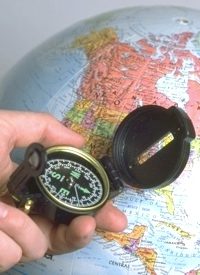
The compass, perhaps the oldest navigational tool of man, does not point to the geographic north pole with its needle. Instead, it indicates the magnetic north pole — which, though close to the geographic north pole, is not at the “top” of the earth’s axis. It is actually in the Arctic Ocean north of Canada, and moves as the magnetic fields of the earth change.
The molten iron core of the spinning earth makes it a giant magnet. However, that magnetic field is actually moving. Jeffrey Love, a research scientist with the U.S. Geological Service’s Geomagnetism Program, notes: “So that means if you wait five years, the compass will be off by one degree.” During some periods the drift of the magnetic north pole has been relatively slight. When it was first identified in 1831, it remained fairly stable for decades. Then, beginning in 1904, scientists began to observe a northeastern shift of about nine miles a year. Since 1989, the drift of the magnetic north pole has accelerated to about 35 miles a year in the direction of Siberia.
The earth’s magnetic field also seems to be weakening. Scientists believe that in the last two centuries, the field has decreased by about five percent per century, after having remained fairly stable for the previous several centuries. Extensive and reliable information has been gleaned from centuries of sea travel. Sailors have long used compasses for navigation, and these sea voyagers have accurately recorded in their log books extensive and reliable information about the winds, tides, direction, stars and other variables. The magnetic orientation of minerals in rocks and pottery shards has also yielded clues about the planet’s magnetic field at different points in history.
The earth’s magnetic field may be in the process of reversing its polarity — something which scientists believe has happened in the distant past of the planet. Although the shift was too far back for historical records to exist, geologists are able to date lava flows to periods of planetary history, and this lava (frozen molten rock) has the same value as pottery shards in fixing the direction of magnetic fields at certain periods of time. David Gubbins, an earth scientist at the University of Leeds in Britain, ties this evidence of the decline in the strength of the planet’s magnetic field to increases of patches of reverse magnetic fields. He speculates on when this process began:
It does look like the patches [of reverse magnetic fields] first formed toward the end of the Eighteenth Century, when Captain Cook was busy sorting out navigation and measuring magnetic field all over the world.
The drift of the magnetic field and the variation in its intensity appear to be the consequence of the intense temperatures in the earth’s core and the liquid flow of iron and nickel which make the planet an electro-magnetic dynamo. Scientists have few tools with which to study the earth’s core. Because of the great depths involved, the intense subterranean heat, and the complexity of mapping the molten mass flowing at the earth’s core, scientists must rely on measurements from the surface to guess the history and the future of the earth’s magnetic field.
The earth’s magnetic field is an important key to life on the planet. It diverts most of that stream of charged particles produced by the sun known as solar winds. Also, changes in the earth’s magnetic field have been connected with climate changes. The drift of the magnetic north pole seem to have little impact upon life on the earth. Only sailors using their instruments of navigation or trekkers in the wilderness with compasses would have noticed the change for most of human history. Interestingly, two airports in Florida have modified the orientation of their runways to reflect the drift.
The weakening of the earth’s magnetic field could expose the planet to increased amounts of solar winds — which, depending upon the extent of the weakening of the magnetic field, could be harmful to life. The layers in the earth’s atmosphere — notably the Van Allen Belt — now trap a substantial amount of the radiation from the solar winds which hit the planet. What happens to the earth’s magnetic field, of course, is only part of the story. The sun itself is highly dynamic and subject to flux. The earth’s magnetic field, along with the intensity of solar winds, would determine the effect of solar winds on life on earth.
How would a complete reversal of the earth’s magnetic field affect life? Geologists note that a “flipping” or reversing of the planetary magnetic fields has occurred in the past, but cannot determine how many shifts there have been, or how often they will occur in the future. Such shifts in the planet’s magnetic field have not been connected to any clear change in life on earth.
About the only thing that scientists can definitely say about the drift of the magnetic north pole, the weakening of the earth’s magnetic field and the shift of its polarity is this: nothing can change these natural events. So if the planet’s climate is changing because the magnetic north pole is gradually becoming the magnetic south pole, humans will necessarily do what they have always done: adapt.



